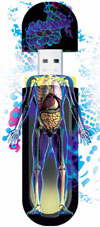21 February 2012
By Devidas Deshpande
In another ten years, we’ll be able to carry our genome codes on a pen drive at an affordable price, promise CDAC scientists
You hand it over and not only does he find out what ailment you have, but what illnesses you could probably contract in the near future and advises you accordingly. The medical practitioner will have your entire genome sequence, which is crucial to determine the nature of body structure.
As much as this sounds like a a scene from a sci–fi flick, if researchers have their way it could become reality in the near future — what’s better is you won’t have to shell out $10,000 for the process, like Steve Jobs did. This is a promise that scientists at the Centre for Development of Advanced Computing (CDAC) have made.

“In the United States, people are talking about having their genome sequencing done for $1,000. We may not have reached that stage yet, but the chance that people may have their gene sequences with them within a decade from now cannot be ruled out,” says Dr Rajendra Joshi, Associate Director and HoD, Bioinformatics Group of CDAC–Pune.
Dr Joshi expressed this possibility after Dr Rajat Moona, the director–general of CDAC, unveiled the Biochrome Cluster – a sophisticated system of processors exclusively dedicated to bioinformatics applications.
The unveiling came on the eve of a three–day symposium on ‘Accelerating Biology 2012: Computing to Decipher’ that is organised by CDAC each year.
Dr Pradeep Sinha, Sr Director (HPC), C–DAC, was also present on the occasion. Speaking to Mirror, Dr Moona said, “Our Bioinformatics Resources and Applications Facility (BRAF) is an effort towards providing high–end supercomputing facilities to researchers working in the areas of life sciences. Biochrome is another supercomputing cluster to augment the BRAF facility.”
BRAF is funded by the Department of Information Technology (DIT), Ministry of Communications and Information Technology, Government of India. Dr Joshi said, “The advent of Next Generation Sequencing technology has brought in a new dimension to understand the molecular basis for the occurrence of diseases.
This technology enables sequencing of hundreds of genomes at an extremely rapid rate and at a significantly lower cost. The availability of hundreds of genomes in a short time is expected to revolutionise the area of medical diagnostics and health care.”
He gave an example of the Human Genome Project that was started in the US about a decade ago. In 13 years with 23 labs across various countries, 500 million genomes were analysed under this project. However, with modern facilities, the same number of genomes can be analysed in just three days.
According to him, a number of new methods like de–novo sequencing, resequencing, sequencing the messenger and non–coding RNA’s (Transcriptomics) etc., are emerging in the Next Generation Sequencing area. The pace of sequencing is leading to a data overload and therefore the ability to analyse is much beyond the existing computing capabilities of individual researchers.
The prediction of carrying one’s genes sequence in pen drive is made on the basis of this advent. To enhance the research in this direction and setting up of an advanced Cyberinfrastructure for life sciences, the Bioinformatics Group of CDAC is collaborating with organisations like National Cancer Institute (NCI) of National Institute of Health (NIH) (USA), Tata Memorial Centre (Mumbai), Roslin Institute (UK), University of Edinburgh (UK), University of Surrey (UK), Oregon Health and Science University (USA), Sanger Institute (UK), National Centre for Cell Science (Pune), University of Pune (Pune), IIT Madras (Chennai) and National Chemical Laboratory (Pune), Dr Moona said.
What is genome sequencingMost of us are familiar with the double–helix DNA strand. This strand has chemical building blocks called bases in the following order –Adenine (A) is followed by a guanine (G), which is followed by a thymine (T), which in turn is followed by a cytosine (C), another cytosine (C), and so on.
So when this particular string is translated it looks like a garbled word : AGTCCGCGAATACAGCTCGGT. While this does not tell the lay person much, when this string is translated by a machine it reads a sequence of one’s DNA bases.
The resulting DNA sequence maps are used by scientists to explore human biology and other complex phenomena. so, if you’re going to go bald at 25, get Alzheimers or are prone to cardiovascular disorders, this lets the scientists and, (if you’re brave enough) you know
Genome sequencing in under an hour for $1000Oxford Nanopore has taken a huge step in genome sequencing by demonstrating a new technology that could deliver a $1,000 genome in under an hour by 2013.
The demonstration of the GridION sequencer was given by the company’s chief technology officer, Clive Brown, at the Advances in Genome Biology and Technology conference in Florida on February 17 to a packed room.
GridION is based on Oxford Nanopore’s own “new generation” of single–strand sequencing technology. Each GridION node and cartridge is designed to deliver tens of GB of sequence data per 24 hour period, with the user choosing whether to run for minutes or days according to the experiment.
Brown also announced a new portable cartridge version called MinION that is so compact it can fit on to a device that doubles as a USB drive and can be plugged into a computer to sequence a genome on the spot.
The sophisticated biochrome clusterAvailable methods of DNA sequencing can only handle short stretches of DNA. Scientists use a machine to analyse stretches of genomes and then piece the pieces of information together.
It is usually a time–consuming process. C–DAC will use the Biochrome Cluster (below), which is an advanced server–based High Performance Computing (HPC) facility.






